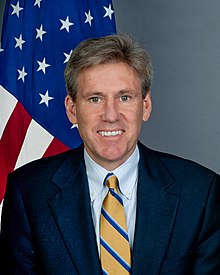J. Christopher Stevens
John Christopher Stevens (born April 18, 1960 in Grass Valley , California , † September 11, 2012 in Benghazi , Libya ) was an American diplomat .
Life
Stevens was born in 1960 to the Californian lawyer Jan S. Stevens and the cellist Mary Stevens (née Floris). Maternal it belonged to the people of the Chinook - Indians on. He grew up with two younger siblings in Marin County . In the late 1960s the family moved to Davis and lived there until his parents divorced in the first half of the 1970s. He studied at the University of California at Berkeley until 1982 . From 1983 to 1985 he stayed as a Peace Corps volunteer in Morocco , teaching English there . He then attended the University of California's Hastings College of the Law , where he obtained his Juris Doctorate in 1989 . In 2010, Stevens received a Master of Science degree from the National War College .
Before joining the State Department in 1991 , he worked as a lawyer specializing in international trade in Washington, DC . Stevens, who spoke French and Arabic , worked in various positions in Washington during his diplomatic career, including Jerusalem , Damascus , Cairo and Riyadh .
From 2007 to 2009 he was Deputy Head of Mission of the United States Diplomatic Mission in Libya . During the civil war in Libya , he served as Special Representative at the National Transitional Council from March 2011 to November 2011 . In May 2012 he succeeded Gene Cretz as the United States' Ambassador to Libya.
On September 11, 2012, Stevens and three American embassy employees were killed in the Benghazi attack . A heavily armed group of fighters attacked the consulate with machine guns, rocket launchers and grenades. Official statements initially only spoke of protests against the Islamophobic video Innocence of Muslims , as it existed in numerous Arab cities, including the US embassy in Cairo. As a result, there was a party political debate about the involvement of organized terrorists and the education by the US government. In late 2013, research by the New York Times disproved assumptions about the involvement of al-Qaeda or systematic planning of the attack. The attack was led by militias, some of which had previously worked with the Americans.
The Yemeni al-Qaeda branch describes the attack on the US consulate in Benghazi as an act of revenge for the killing of Abu Yahya al-Libi , who died in a US drone attack in Pakistan on June 4, 2012 .
In June 2014, Ahmed Abu Khatallah was caught by US special forces in Benghazi . The commandant of Ansar al-Sharia is accused of being the mastermind behind the attack on the consulate.
reception
- Mitchell Zuckoff with Annex Security Team: 13 Hours: The Inside Account of What Really Happened in Benghazi. Hachette Book Group, 2014, ISBN 978-1-4555-8227-3 .
- 13 Hours: The Secret Soldiers of Benghazi - Film based on the above book by Michael Bay
See also
Web links
- Biography ( September 12, 2012 memento on the Internet Archive ) on the United States Department of State website (2012)
- Slain US ambassador to Libya remembered for his languages, service , September 12, 2012, Los Angeles Times
- US government confirms the death of its ambassador in Libya , September 12, 2012, Süddeutsche.de
- Bernard-Henri Lévy : Remembering Libyan Ambassador Christopher Stevens , September 12, 2012, The Daily Beast
Individual evidence
- ^ A b c Stevens remembered as a man who cared deeply for Libya , September 12, 2012, The Salt Lake Tribune
- ^ Slain ambassador was a member of the local Chinook Tribe . chinookobserver.com. July 20, 2018. Archived from the original on September 16, 2012. Retrieved on August 31, 2016.
- ↑ "Killed US ambassador was Chinook Indian", in: "Coyote - Indianische Gegenwart", Ztschr. Of the "Action Group Indians and Human Rights eV", Munich, issue 95, autumn 2012, p. 9
- ↑ Sebastian Fischer, Terrorist attack in Libya: Benghazi emails get Clinton into trouble - Spon, May 11, 2013
- ^ Jordan Michael Smith: How Congress left our embassies exposed - salon.com , September 12, 2012
- ↑ Nicolas Richter: Diluted wording - SZ, May 13, 2013
- ↑ David D. Kirkpatrick: A Deadly Mix in Benghazi . New York Times, December 28, 2013
- ↑ Protests against the innocence of Muslims : Chronology of events ( Memento from September 19, 2012 in the Internet Archive ), tagesschau.de , September 18, 2012. (Date of query: September 18, 2012)
- ^ New York Times: US captures Benghazi suspect in secret raid , June 17, 2014
| personal data | |
|---|---|
| SURNAME | Stevens, J. Christopher |
| ALTERNATIVE NAMES | Stevens, John Christopher (full name) |
| BRIEF DESCRIPTION | American diplomat |
| DATE OF BIRTH | April 18, 1960 |
| PLACE OF BIRTH | Grass Valley , California |
| DATE OF DEATH | September 11, 2012 |
| Place of death | Benghazi |
